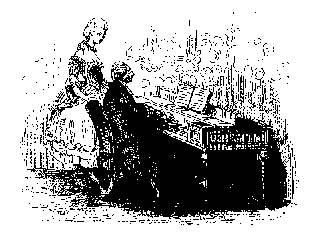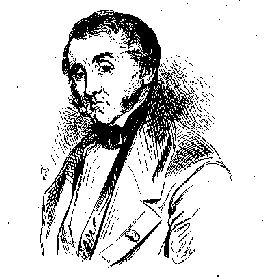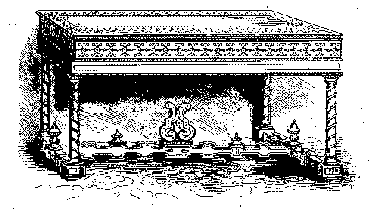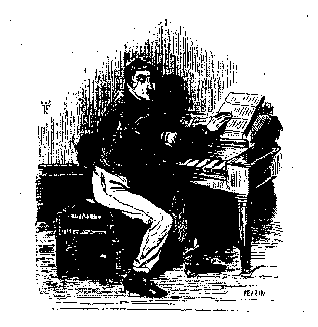

The transition from the organ to the piano is natural. Since Sebastian Erard, great improvements have been made in this latter instrument. Pierre Erard has ably sustained the reputation of the establishment founded by his uncle, of whose successful efforts we have already given a slight sketch.
There is more rivalry to compete with at the present day ; witness Petzold, Pleyel, Roller, and Dietz, who have brought piano-making to a great degree of perfection.
Among the artists in this line, we must mention M. Pape, who, by repeated efforts, has succeeded in enriching his art with numerous improvements.
Jean Henri Pape, born in 17789, in Hanover, was apprenticed at an early age to a cabinet-maker. Reached by the conscription in 1809, the young man did not hesitate to expatriate himself, and to sacrifice his little patrimony. He set out for Paris, where he arrived as if by miracle, having succeeded in travelling, without a passport, through numerous districts where the administration exercised a rigorous surveillance. In 1810, M. Pape entered Ignatius Pleyel's establishment as a workman. He soon distinguished himself here by his activity and intelligence, and became a skilful mechanic. He afterwards went to England to gain information in his branch of trade ; for, at that time, our English neighbors enjoyed a marked superiority in their pianos.

Upon his return to France, M. Pape founded an establishment which obtained a legitimate and rapid success. Besides the importation of English pianos, we also owe to this laborious and industrious artist a number of improvements for which he has taken patens, and which have effected a sort of revolution in piano-making.
[A son retour en France, M. Pape fonda un établissement qui obtint de légitimes et rapides succès. Outre l'importation des piano fabriqués d'après le système anglais, on doit encore à ce laborieux et industrieux artiste une foule d'améliorations et d'innovations importantes, constatés par de nombreux brevets d'invention, et qui ont opéré un sorte de révolution parmi les facteurs de pianos.]
It is well know, says M. Anders, in the Paris Musical Gazette, that the ordinary system of pianos consists in placing the mechanism of the hammers under the strings ; in M. Pape's instruments, on the contrary, the hammers are placed over, and strike the chords from above. It was in 1826, that M. Pape conceived the idea of this change. He exhibited an instrument constructed upon this plan, in 1827 ; but the critics opposed this innovation, objecting that the hammer could not be raised but by a spring, or a counterpoise, and would necessarily incumber the finger-board ; it was added that the springs would lose their power by constant use, and the instrument be liable to continual derangement.
M. Pape, far from being discouraged or mortified by these observations, redoubled his efforts in favour of his system l he had recognised the advantages of it, and nummerous experiments followed each other for several years. Thanks to a most rare perseverance, he at last overcame all obstacles, and obtained the most satisfactory results. At the exhibition of 1834, he presented pianos of a new construction, the improved mechanism of which was of a nature to disarm criticism, and obtained the gold medal. From that time, M. Pape has not ceased to continue his researches, and there is no one department in which his labours have not introduced great improvements.
Among the new pianos which the art of music owes to M. Pape, we shall make a passing mention of the organized piano, which is an upright instrument of the ordinary size, into which he has introduced a physharmonica ; the harmonica, with a finger-board of various substances, both crystal and metal, and provided with small lappets of cloth to prevent confusion of sounds ; the piano without strings, an instrument in which the strings are replaced by metallic plates, or rather springs of steel, and the vibration obtained by the aid of small hammers. The sound of this instrument partakes of the nature of the harp as well as that of the piano.
M. Pape has varied the form of his pianos in the most beautiful and graceful manner. His hexagonal piano, representing a little stand, is a very pretty piece of furniture, and much sought after by the English. It is difficult to understand how this little table ; three feet high, standing in the middle of an elegant room, can be a piano. There is also the pier-table piano, of so small a size as to astonish beholders. M. Francoeur, in his report upon the variety of new pianos, makes laudatory mention of M. Pape's instruments, and especially those of small size. "These," says he, "are remarkable for beauty, and may be placed in any part of a room. The excellence of the mechanism is equal to that of the sounds to be obtained from them."

[M.Pape a su varier la forme de ses pianos de la manière la plus élégante et la plus gracieuse. Ainsi, son piano hexagone, en forme de guéridon, est un joli meuble heureusement conçu, et qui a obtenu un grand succès en Angleterre. A voir cette espèce de table de salon de trois pieds de diamètre, on devinerait difficilement que c'est un instrument de musique. Il y a aussi le piano-cosole, petit piano d'une dimension tellement réduite, qu'il semble impossible de la réduire davantage ; il est construit d'après le système du piano à queue. M. Francoeur, dans son rapport sur les nouveaux pianos à queue et consoles, dit que M. Pape a imaginé de faire servir le tirage même des cordes à tendre la table, et par ce moyen il évite, non-seulement la détérioration causée ordinairement par le tirage sur la table, mais la dispose, au contraire, à acquérir plus de sonorité. Ce charmant petit meuble peut trouver place partout fort aisément. Il ne se recommande pas moins par la perfection du mécanisme que par la qualité des sons.]
M. Pape's inventive genius has gone further. Among other innovations, the invention of his spiral saw has enabled him to obtain thin sheets of ivory, fifteen feet long, and two feet and a half wide. It was with this machine that the ivory covering the beautiful piano so much admired at the exhibition of 1839, was produced.
Other important inventions, relative to his art, have spread M. Pape's reputiation all over Europe, notwithstanding the opposition he has met with from enemies. The mechanism which bears his name, at first cried down, has of late years been adopted by all piano-makers. Another invention, slighted when published as a theory, has, when put into practice, been esteemed essential to the perfection of sound : this is the substitution of felt for leather, in covering the hammers.
Finally, M. Pape's instruments have received the suffrages of learned men, artists and amateurs. He successively obtained the silver and gold medals at the exhibitions, the large gold medal, offered by the Society for Encouragement, in 1838, and, at the last exhibition, the badge of the Legion of Honour ; rewards well adapted to a life consecrated to indefatigable labours in an art which spreads so great a charm over society.
In 1827, M. Pape's establishment maintained eighty workmen ; in 1834, this number increased to a hundred and fifty, and four hundred pianos were there constructed annually. Since that time the prosperity of this fine establishment has continued to increase, nor could it do otherwise, having so skilful a director at its head.
Before leaving this branch of art, we shall take occasion to mention one whose remarkable efforts excite both astonishment and admiration, and whose success is a new and striking example of the power of will. Blind from a very early age, he of whome we speak did for music what Saunderson did, in the last century, for mathematics.

This man is Claude Montal, who owes to himself alone the high reputation he now enjoys in the musical world. Twelve years ago, he fulfilled with great credit to himself, the functions of a tutor in the Institution for the Blind, founded by Valentine Hauy. It was here that the young Montal passed his childhood and youth, that he began to cultivate his intelligence, and that he expected to pass his whole life in instructing his companions. He was ignorant of his true vocation ; an accidental circumstance revealed it to him, and inspired him with an ardent desire to maintain himself in an entirely different sphere. He heard that much money might be made by tuning pianos. His whole ambition was now directed to this subject. He gave himself up to laborious study ; and, with the fruit of his savings, which were but small, purchased a piano, and studied the mechanism of it little by little, with an attentive sagacity, seeking to become complete master of every one of its details.
He paid some young men to read various works to him, of a nature to enlighten his researches. In this manner he soon attained great skill in tuning pianos ; by degrees the fame of his talent spread ; the most celebrated professors took a pleasure in encouraging him ; and, from that time, Montal was esteemed at the head of his art. He is, in fact, the only professor of tuning in France. He has gone further ; he has published a luminous and learned theory of his art, entitled The Art of Tuning one's own Piano.
Having become tuner to the most renowned professors of the Conservatoire, M. Montal determined to extend his sphere, and become a piano-maker. His attempts of various kinds have been honoured with the notice of connoisseurs, and raised him to an honourable place among piano-makers.
[On remarque dans ses pianinos un nouveau chevalet qui, par sa disposition, se trouve collé en pleine table, sans diminuer la longueur des cordes ; ce qui procure plus de vibration dans la basse de cese petits instruments, qui en est ordinairement la partie faible. De plus, M. Montal a imaginé des enfourchements en cuivre isolés pour chaque note, et laissant aux marteaux la faculté de s'enlever isolément au lieu d'être tenus douze par douze, comme dans les pianos ordinaires. Il résulte de ce perfectionnement plus de solidité pour l'instrument et plus de promptitude dans la répétition des notes.
M. Montal fait aussi fabriquer dans ses ateliers des pianos droits, des pianos carrés et des pianos à queues.
Les pianos droits sont faits à l'instar de ceux M. Roller, avec des changements d'amélioration dans la mécanique et dans le tablage. Les pianos carrés offrent un perfectionnement du système d'agrafes en cuivre introduit par Erard. Ces pianos sont à sommier prolongé, et doublés en cuivre ; le barrage de la table et la mécanique présentent des améliorations : ce sont d'abord des ressorts suspendus, c'est-à-dire sans frottement, et susceptibles de plus de durée qu'aucun ressort connu. Ajoutez à ce premier avantage une mécanique anglaise qui a la faculté de se baisser ou de se hausser à l'aide de vis de rappel, sans nuire à l'attaque et à la précision du clavier. On peut signaler encore dans ces pianos carrés un perfectionnement du bouton de rappel, qui assure la solidité de cette partie du mécanisme. Quant aux pianos à queues, ils sont exécutés d'après le système d'Erard modifié.]
Such have been the remarkable efforts of M. Montal, efforts really prodigious if we consider the difficulties with twhich he had to struggle. Blind, without fortune or master, he has yet acquired a distinguished place in his art, - one which requires long and persevering study. In future years M. Montal will be spoken of as one of the greatest wonders of our epoch.